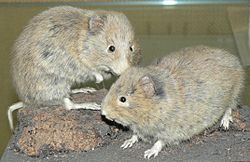Orkney vole facts for kids
Quick facts for kids Orkney vole |
|
|---|---|
 |
|
| Orkney vole (Microtus arvalis orcadensis) in the Natural History Museum at Tring | |
| Conservation status | |
| Scientific classification | |
| Kingdom: | |
| Phylum: | |
| Class: | |
| Order: | |
| Family: | |
| Subfamily: |
Arvicolinae
|
| Genus: |
Microtus
|
| Species: | |
| Subspecies: |
M. a. orcadensis
|
| Trinomial name | |
| Microtus arvalis orcadensis |
|
| Synonyms | |
|
Microtus orcadensis |
|
The Orkney vole (Microtus arvalis orcadensis) is a special type of common vole. You can find these small, furry creatures in the Orkney Islands, which are off the northern coast of Scotland. They also live on the Channel Island of Guernsey.
Orkney voles are a bit bigger than other common voles. They are about 10% larger! Interestingly, you won't find the common vole anywhere else in the British Isles. This makes the Orkney vole quite unique.
Contents
Where Do Orkney Voles Live?
The Orkney vole lives on eight different islands in the Orkney group. These islands include Mainland, Sanday, Westray, Rousay, South Ronaldsay, Burray, Eday, and Stronsay. They like to live in grassy areas and fields.
Understanding Orkney Vole Classification
Scientists who study how living things are grouped, called taxonomists, have different ideas about the Orkney vole. Some think it's a special type, or subspecies, of the common vole. This is mainly because it's larger than other common voles.
However, other scientists don't think there are any subspecies of the common vole. This is especially true since DNA tests show that Orkney voles might have come from what is now Belgium. Even though Orkney voles can be twice as heavy as voles from mainland Europe, chromosome studies show they are the same species. So, most scientists now agree they are a subspecies.
How Did Orkney Voles Arrive?
The common vole (Microtus arvalis) doesn't naturally live in mainland Britain or other parts of the British Isles. For a while, people thought the Orkney voles were a relict population. This means they were left behind when the land that connected Scotland and Orkney disappeared. This idea also suggested that another type of vole, the field vole, hadn't reached Northern Scotland yet.
But this old idea has now been proven wrong. Scientists looked at old fossils, how animals live, and the geology of the land. They found that the Orkney voles didn't just stay behind.
It is now believed that humans brought these voles to the Orkney archipelago a very long time ago. This happened during the Neolithic period, which was the New Stone Age. The voles might have hidden in animal food or other supplies that people carried with them. The oldest known fossil of an Orkney vole is about 4,600 years old. This means they arrived at least by that time.
See also
 In Spanish: Topillo campesino para niños
In Spanish: Topillo campesino para niños


